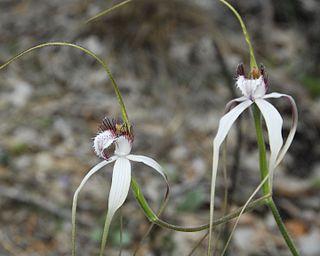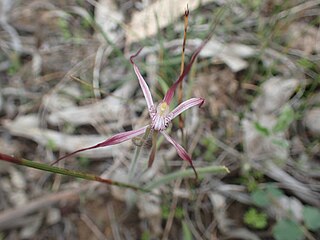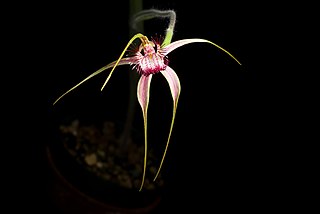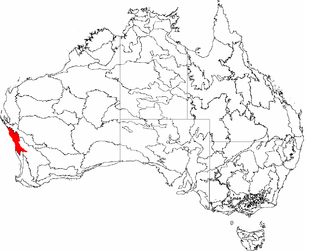
Caladenia longicauda is a species of plant in the orchid family Orchidaceae and is endemic to the south-west of Western Australia. It is distinguished by its large leaf and by its up to five large, white flowers which have drooping sepals and petals with long, thickish brown "tails".

Caladenia paludosa, commonly known as the swamp spider orchid, is a species of orchid endemic to the south-west of Western Australia. It has a single erect, hairy leaf and up to three red, greenish-yellow and cream-coloured flowers. It mostly grows in dense scrub and is one of the last of the similar spider orchids to flower.

Caladenia longicauda subspecies borealis, commonly known as daddy-long-legs spider orchid is a plant in the orchid family Orchidaceae and is endemic to the south-west of Western Australia. It has a single hairy leaf and up to three mostly white flowers with long, drooping sepals and petals.
Caladenia erythrochila, commonly known as the Lake Muir spider orchid, Lake Muir blood spider orchid, Harry's little red spider orchid and Lake Muir blood orchid is a species of orchid endemic to a small area in the southern corner of the south-west of Western Australia. It has a single, hairy leaf and long, wispy, thread-like sepals and petals. Most of the flower parts are blood red, although there are often white marks on the labellum.

Caladenia excelsa, commonly known as the giant spider orchid, is a species of orchid endemic to a small area in the south-west of Western Australia. It is a rare species with a single, hairy leaf and up to three cream-coloured to greenish-cream flowers with long, drooping sepals and petals. It is one of the tallest spider orchids in Western Australia and, with Caladenia splendens, has the largest flowers of any Western Australian orchid.

Caladenia heberleana, commonly known as Heberle's spider orchid, is a species of orchid endemic to the south-west of Western Australia. It has a single, hairy leaf and up to three red, white and pale yellow flowers which have a white, red-tipped labellum.
Caladenia hoffmanii, commonly known as Hoffman's spider orchid is a species of orchid endemic to the south-west of Western Australia. It has a single, hairy leaf and one or two, greenish-yellow, red and white flowers which have a greenish-yellow labellum with a red tip. It is distinguished from the Pingaring spider orchid by small differences in the labellum and more northerly distribution.
Caladenia incensum, commonly known as the glistening spider orchid is a species of orchid endemic to the south-west of Western Australia. It has a single, hairy leaf and three glistening white flowers which have a red-striped labellum.
Caladenia longicauda subsp. albella, commonly known as the small-lipped white spider orchid, is a plant in the orchid family Orchidaceae and is endemic to the south-west of Western Australia. It has a single hairy leaf and up to four, mostly white flowers which have a pungent smell. It usually grows in seasonal swamps between Eneabba and Gingin.

Caladenia longicauda subsp. longicauda, commonly known as the white spider orchid, is a plant in the orchid family Orchidaceae and is endemic to the south-west of Western Australia. It has a single hairy leaf and up to four, mostly white flowers with long drooping, thread-like ends on the sepals and petals. It grows in woodland and forest.

Caladenia longicauda subsp. merrittii, commonly known as Merritt's white spider orchid, is a plant in the orchid family Orchidaceae and is endemic to the south-west of Western Australia. It has a single hairy leaf and up to three large, mainly white flowers with very long, drooping lateral sepals and petals, and a white broad labellum with relatively short labellum teeth. It is one of the largest spider orchids.

Caladenia lorea, commonly known as the blushing spider orchid, is a species of orchid endemic to the south-west of Western Australia. It has a single, hairy leaf and up to three cream, pink and red flowers and often hybridises with the white spider orchid producing intermediate forms.
Caladenia nobilis, commonly known as the noble spider orchid, is a species of orchid endemic to the south-west of Western Australia. It has a single hairy leaf and one or two large white flowers with a red-marked labellum.

Caladenia occidentalis, commonly known as the ruby spider orchid, is a species of orchid endemic to the south-west of Western Australia. It has a single erect, hairy leaf and one or two pinkish-red flowers with a white, red-striped labellum.
Caladenia pendens subsp. pendens, commonly known as the pendant spider orchid, is a plant in the orchid family Orchidaceae and is endemic to the south-west of Western Australia. It has a single hairy leaf and up to three relatively large, creamy-white flowers with long drooping petals and sepals and sometimes has a sickly-sweet scent.

Caladenia pendens subsp. talbotii, commonly known as Talbot's spider orchid, is a plant in the orchid family Orchidaceae and is endemic to the south-west of Western Australia. It has a single hairy leaf and one or two white, red and yellow flowers with long drooping petals and sepals and sometimes has a citrus-like scent.
Caladenia pholcoidea subsp. pholcoidea, commonly known as the Albany spider orchid, is a plant in the orchid family Orchidaceae and is endemic to the south-west of Western Australia. It has a single hairy leaf and up to four pale yellow flowers with long drooping petals and lateral sepals.
Caladenia postea, commonly known as the dark-tipped spider orchid, is a species of orchid endemic to the south-west of Western Australia. It has a single erect, hairy leaf and up to three small, pale creamy-white flowers. It has a relatively late flowering period compared to similar spider orchids.

Caladenia serotina, commonly known as the Christmas spider orchid, is a species of orchid endemic to the south-west of Western Australia. It has a single erect, hairy leaf and up to three white to cream-coloured and red flowers, although the relative amount of each is variable. It is one of the later-flowering spider orchids and occurs in the far south-west corner of the state.

Caladenia speciosa, commonly known as the sandplain white spider orchid, is a species of orchid endemic to the south-west of Western Australia. It has a single erect, hairy leaf and up to three relatively large white flowers tinged with pink and with a fringe of long teeth on the sides of the labellum.
























